
Illustrating Connecticut - River Valley

|
|
|
H. H. Art Studios, Inc. "1176 Miles in 76 Hours! Hartford’s Columbia gasoline touring car sets new record for Chicago-New York run,", 1947  Drawing on paper, 13 ½ x 11" Another area of industry where Connecticut excelled was in bicycle manufacturing, and its spin-off, the earliest automobile manufacturing. Albert Pope of Hartford saw a bicycle in Philadelphia in 1876 and was immediately enthralled with the concept of an "ever-saddled horse that eats nothing and requires no care." He subsequently began the first bicycle manufacturing in America, Columbia Bicycles and set about marketing the vehicle, setting up a system of distributorships with fixed prices, hiring doctors to tout cycling as healthy exercise, and founding cycling magazines. The Pope Manufacturing Company was the forerunner of present day automobile corporations. H. H. Art Studios, Inc. "It’s Nice to know how far you go,", 1947 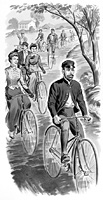 Drawing on paper, 13 ½ x 11" Curtis H. Veeder (1862-1943), a draftsman at the Hartford Cycle Company, perfected compound differential gearing, facilitating the invention of the cyclometer that recorded the miles traveled on a bicycle. In 1895, he founded the Veeder Manufacturing Company and produced speedometers for automobiles. He expanded his business and partnered with the Charles Root Company to manufacture counters for machine-guns, jukeboxes, vending machines, and taxi meters as well as ammunition counters, walkie-talkies, high speed radar counters, and other specialized equipment. Their slogan, “Veeder-Root counters count everything on earth,” proved to be true! Lonni Sue Johnson Cherry Valley, New York; formerly Sherman, Connecticut Noah Webster’s Dictionary, 2007  Watercolor and gold paint, 7 ½ x 6" Noah Webster (1758-1843), father of the modern dictionary, was born in 1758 in West Hartford, Connecticut. From 1801-28, he wrote An American Dictionary of the English Language to standardize American vocabulary, spelling, and pronunciation. Bob Kessel Norwich, Connecticut Olmsted Park, 2006 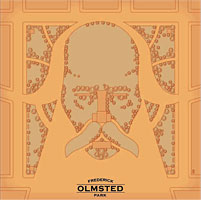 Ink jet on archival Somerset paper, 22 x 30" Frederick Law Olmsted (1822-1903) was born in Hartford, Connecticut. A champion of the City Beautiful movement, he is recognized as the founder of American landscape architecture, designing with Calvert Vaux New York City’s Central Park and Prospect Park, Chicago’s Riverside subdivision, Buffalo’s park system, and the Niagara Reservation at Niagara Falls. Olmsted designed Connecticut’s Seaside and Beardsley Parks in Bridgeport, Walnut Hill Park in New Britain, Memorial Park in New London (one of only two cemeteries that he designed), and the Institute of Living in Hartford. He also made many sketches for the state Capitol in Hartford, which were never realized. Many other projects in the state were designed later by his sons through the Olmsted Brothers firm that he founded. In July 2005, the General Assembly passed a bill proclaiming April 26 of each year to be Frederick Law Olmsted Day to honor his betterment of American society through the creation of pastoral respites for all classes of people in crowded urban settings. Walter O. R. Korder (1891-1962) Hartford, Connecticut Andross Demands Connecticut Charter, c. 1940 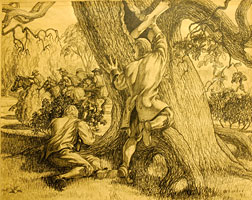 Pencil, 12 x 15" In 1662, King Charles II of England granted the Connecticut Colony a Royal Charter with liberal autonomy. His successor, King James II, asserted tighter control, and in 1687, overrode their rights by appointing Sir Edmund Andross, then governor of New York, as governor of the Dominion of New England. Andross demanded Connecticut relinquish the charter to him, threatening to split the state between Massachusetts and New York along the Connecticut River. He traveled from Boston to Hartford, and during a debate and scuffle at Butler’s Tavern, Captain Joseph Wadsworth with others snuck the charter from the room and hid it in an oak tree on Wyllys Hill. The Charter Oak is now celebrated as the state tree. The Museum of Connecticut History displays a parchment that it regards as the original charter. (The Connecticut Historical Society is said to possess a "fragment" of it.) In addition, the ceremonial seat of the president of the Connecticut Senate is made from the oak tree, which was destroyed during a severe storm in 1856. Barry Moser North Hatfield, Massachusetts Mark Twain, 1985 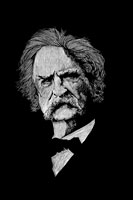 Wood engraving, 12 x 10" Mark Twain (Samuel Langhorne Clemens, 1835-1910) lived in Hartford, Connecticut, from 1871-91, where he completed some of his most famous works, including The Adventures of Tom Sawyer, Life on the Mississippi, The Prince and the Pauper, A Connecticut Yankee in King Arthur’s Court, and Huckleberry Finn. He left the state to travel worldwide and to live in New York City, returning in 1908 to his "Stormfield" house in Redding, Connecticut, where he died in 1910. His Hartford Courant obituary claimed him as the city’s son, stating, "the feeling has never died out here that he belonged to Hartford, and this has been intensified by the fact that wherever any Hartford traveler went the first question asked of him was whether he knew Mark Twain." Barry Moser created this frontispiece for the centenary edition of Huckleberry Finn published first by Pennyroyal Press in celebration of Samuel Langhorne Clemens. Merle Nacht New Haven, Connecticut Old State House, 1997 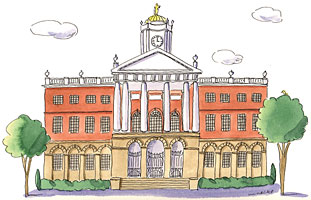 Pen, ink, and watercolor, 7 ¼ x 11 ¾" The Old State House in Hartford, Connecticut, is the oldest state house in the United States, and served as the seat of state government until 1878. Completed in 1796, it was designed by Charles Bulfinch, the first architect to gain national prominence and the architect of the United States Capitol Building in Washington, DC. Throughout the 1790s, Hartford emerged from the post-Revolution depression as a stable center for commercial and social growth. Today the rich history of the Old State House remains a symbol of pride for Connecticut residents. On the site in 1637, the first written constitution guaranteeing the right to representative government was enacted by British colonists, earning the state its nickname, “The Constitution State.” In addition, the Old State House has welcomed many visitors, including Presidents Jackson, Monroe, Johnson, Ford, Carter, and Bush as well as Mark Twain, Charles Dickens, Samuel Colt, P. T. Barnum, and Harriet Beecher Stowe. |
|



